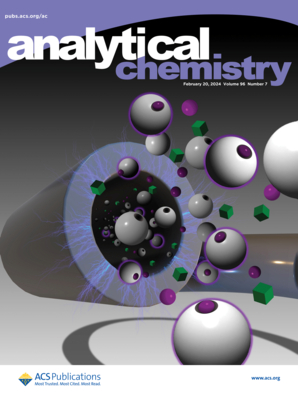Novel Urazole-Derived MS-Cleavable Cross-Linkers Targeting Tyrosine/Lysine Residues for Protein Structural Analysis.
IF 6.7
1区 化学
Q1 CHEMISTRY, ANALYTICAL
引用次数: 0
Abstract
Chemical cross-linking mass spectrometry (XL-MS) is crucial for probing protein structure and protein-protein interactions. Currently, lysine-reactive cross-linkers have been widely developed and applied. In this study, two urazole-derived MS-cleavable cross-linkers were designed and synthesized, enabling the accurate identification of cross-linked peptides by MSn. A homobifunctional cross-linker (sulfoxide, bis-urazolyl, SBT) was designed to target tyrosine residues through the electrochemical click reaction. Another heterobifunctional cross-linker (sulfoxide, succinimidyl, urazolyl, SCT) was synthesized to target lysine and tyrosine residues. The reaction efficiencies of cross-linkers were systematically evaluated by using them to react with peptides, proteins, and protein complexes, respectively. Additionally, five structures of BSA, derived from AlphaFold 3, were analyzed by comparing them with its crystal structure in the protein database. The results demonstrate that this type of urazole-derived cross-linker is a valuable addition to the existing cross-linker library and enhances the recognition coverage of XL-MS in the structural analysis of proteins.针对酪氨酸/赖氨酸残基的新型乌拉唑衍生的ms可切割交联剂用于蛋白质结构分析。
化学交联质谱(XL-MS)是探测蛋白质结构和蛋白质相互作用的关键。目前,赖氨酸反应性交联剂得到了广泛的开发和应用。本研究设计并合成了两个乌拉唑衍生的ms可切割交联剂,实现了用MSn对交联肽的准确鉴定。设计了一种双功能交联剂(亚砜,双乌拉唑,SBT),通过电化学点击反应靶向酪氨酸残基。合成了另一种杂双功能交联剂(亚砜、琥珀酰亚胺基、脲唑基、SCT)以赖氨酸和酪氨酸残基为靶点。通过与多肽、蛋白质和蛋白质复合物的反应,系统地评价了交联剂的反应效率。此外,通过与蛋白质数据库中的BSA晶体结构进行比较,分析了从AlphaFold 3中提取的5种BSA结构。结果表明,这种乌拉唑衍生的交联剂对现有的交联剂库是一个有价值的补充,并提高了xml - ms在蛋白质结构分析中的识别覆盖率。
本文章由计算机程序翻译,如有差异,请以英文原文为准。
求助全文
约1分钟内获得全文
求助全文
来源期刊

Analytical Chemistry
化学-分析化学
CiteScore
12.10
自引率
12.20%
发文量
1949
审稿时长
1.4 months
期刊介绍:
Analytical Chemistry, a peer-reviewed research journal, focuses on disseminating new and original knowledge across all branches of analytical chemistry. Fundamental articles may explore general principles of chemical measurement science and need not directly address existing or potential analytical methodology. They can be entirely theoretical or report experimental results. Contributions may cover various phases of analytical operations, including sampling, bioanalysis, electrochemistry, mass spectrometry, microscale and nanoscale systems, environmental analysis, separations, spectroscopy, chemical reactions and selectivity, instrumentation, imaging, surface analysis, and data processing. Papers discussing known analytical methods should present a significant, original application of the method, a notable improvement, or results on an important analyte.
 求助内容:
求助内容: 应助结果提醒方式:
应助结果提醒方式:


